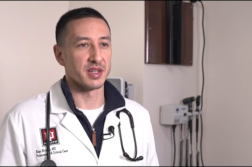CHICAGO, Ill. (Ivanhoe Newswire) – Pulmonary embolism can be life-threatening and affects around one in 1,000 people in the U.S. every year. In most cases, pulmonary embolism is caused by blood clots in the legs or arms that travel to the lungs. With timely treatment, most people can recover. But for some, those clots become chronic, and even the most physically fit people can fall victim.
Fifty-three years after his big win with the Celtics, number seven, Em Bryant, has still got it!
He still proudly wears his 1969 championship ring. This 85-year-old works hard to stay fit on and off the court.
“I was used to being in the gym for a couple hours and then swimming a quarter mile and half a mile,” Bryant says.
But then, his pulmonologist, Michael Cuttica, MD at Northwestern Medicine, noticed that he had a series of clotting events or pulmonary embolism in the lung, and never fully recovered from it.
The fatigue Bryant felt was a clear sign that his clots did not go away with blood thinners.
Dr. Cuttica explains, “When I met them, they got to the point where he couldn’t even go for walks with his wife.”
When clots don’t go away, they can turn into scar tissue, or chronic clots in the walls of the pulmonary arteries, and this can lead to chronic thromboembolic pulmonary hypertension, or CTEPH.
Bryant underwent a pulmonary thromboendarterectomy surgery. Surgeons attached Bryant to a heart-lung bypass machine, cooling his body to 64 degrees Fahrenheit to protect his organs. Surgeons then turned off the heart-lung machine, stopping circulation for up to 20 minutes. They opened the arteries and remove the clots. After a week in the hospital, Bryant was back home, and a few months later, he was back in the gym.
“I’ve since learned how to pace myself, now,” Bryant explains.
Dr. Cuttica expresses, “I look forward to the day where I get to go and shoot some hoops with him.”
For patients who are not well enough or strong enough for the ten hour PTE surgery, doctors can also try medications, or use a minimally invasive balloon catheter to try and push the clots out of the way. If not treated, the clots can become life-threatening.
Contributors to this news report include: Marsha Lewis, Producer; Roque Correa, Videographer & Editor.
To receive a free weekly e-mail on medical breakthroughs from Ivanhoe, sign up at: http://www.ivanhoe.com/ftk
MEDICAL BREAKTHROUGHS
RESEARCH SUMMARY
TOPIC: NBA STAR GETS PTE FOR PULMONARY BLOOD CLOTS
REPORT: MB #5104
BACKGROUND: CTEPH — or chronic thromboembolic pulmonary hypertension — is a rare, life-threatening medical condition typically caused by old blood clots in the lungs (pulmonary emboli). Most people who have suffered a blood clot can be treated with blood thinners to restore blood flow to the lungs, which helps improve their breathing and exercise tolerance. However, in others, blood clots might not dissolve and can lead to progressive right-sided heart failure and/or development of pulmonary hypertension (increased blood pressure in the lung). CTEPH has been estimated to occur in 0.1 to 0.5% of patients who survive an episode of PE, or pulmonary embolism, which equates to 500 to 2,500 annual cases in the United States alone. More recent data indicate that the incidence of CTEPH may be much higher than these studies suggest.
DIAGNOSING: Chronic thromboembolic pulmonary hypertension symptoms include chest pain or tightness, cyanosis (fingers and toes with a bluish tint), dizziness, fatigue, pounding in your chest (also known as heart palpitations), shortness of breath, especially during physical activity, and/or swollen legs due to fluid retention (edema). Your care may start with tests to check for signs of CTEPH. These include lung ventilation-perfusion scan (V/Q scan), pulmonary function tests, transthoracic echocardiogram (TTE), or an MRI.
NEW TECHNOLOGY: Pulmonary angiography remains the gold standard approach for the confirmation of the diagnosis and pre-surgical evaluation of CTEPH. New emerging technologies such as Dual-Energy Computed Tomography angiography (DECT) and Computed Tomography angiography (CTA) are developing and broadly available. These noninvasive methods provide diagnostic information similar to conventional pulmonary angiography and surgical operability information. They are to be considered as an alternative in the diagnostic approach of patients with CTEPH as presented in the ESC/ERS guidelines. Hemodynamic measurement whiles exercising during right heart catheterization may improve diagnostic sensitivity of CTEPH and could therefore be used as a diagnostic test in patient with normal hemodynamic at rest.
FOR MORE INFORMATION ON THIS REPORT, PLEASE CONTACT:
Megan McCann
(312) 926-5900
If this story or any other Ivanhoe story has impacted your life or prompted you or someone you know to seek or change treatments, please let us know by contacting Marjorie Bekaert Thomas at mthomas@ivanhoe.com




